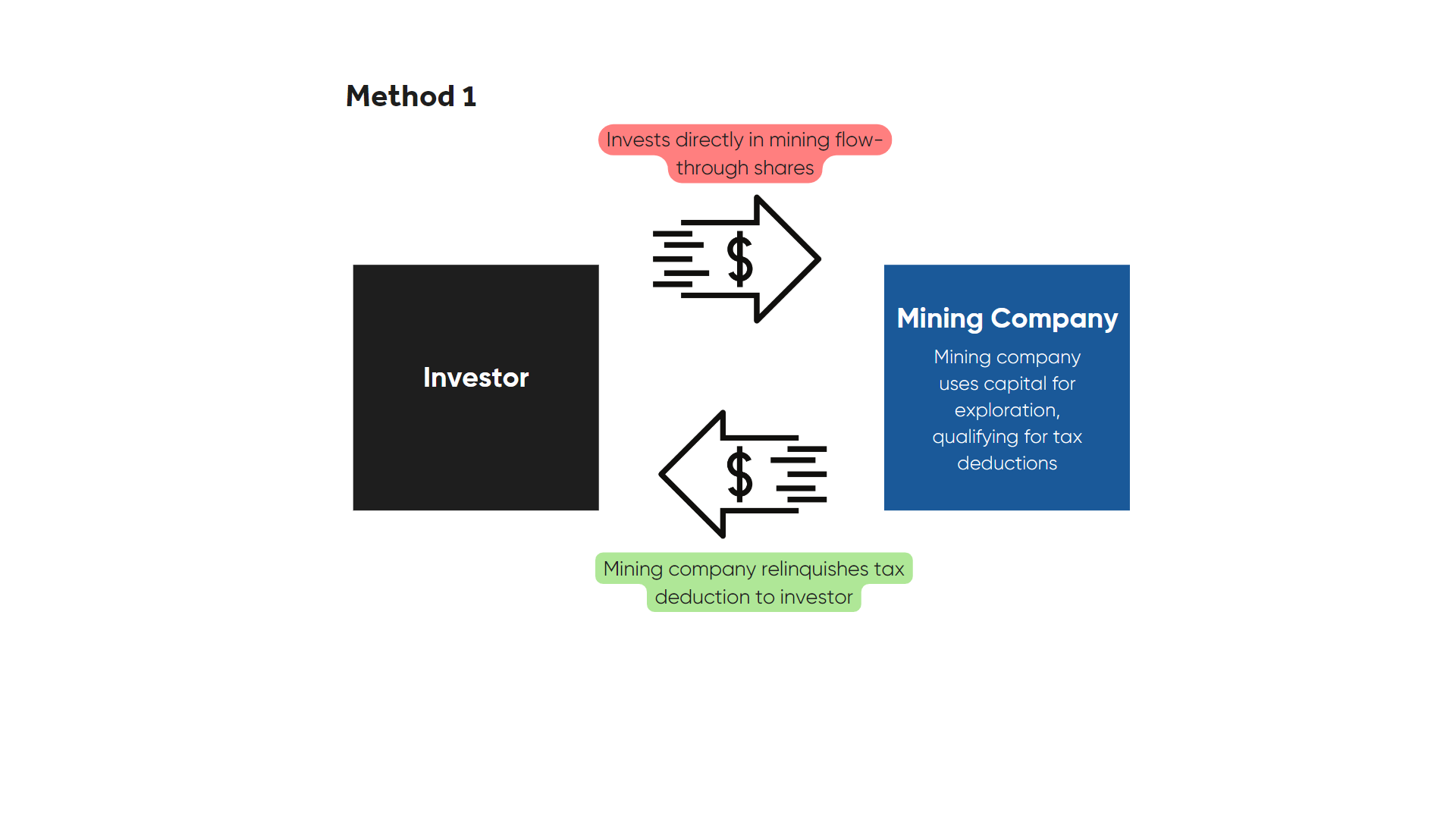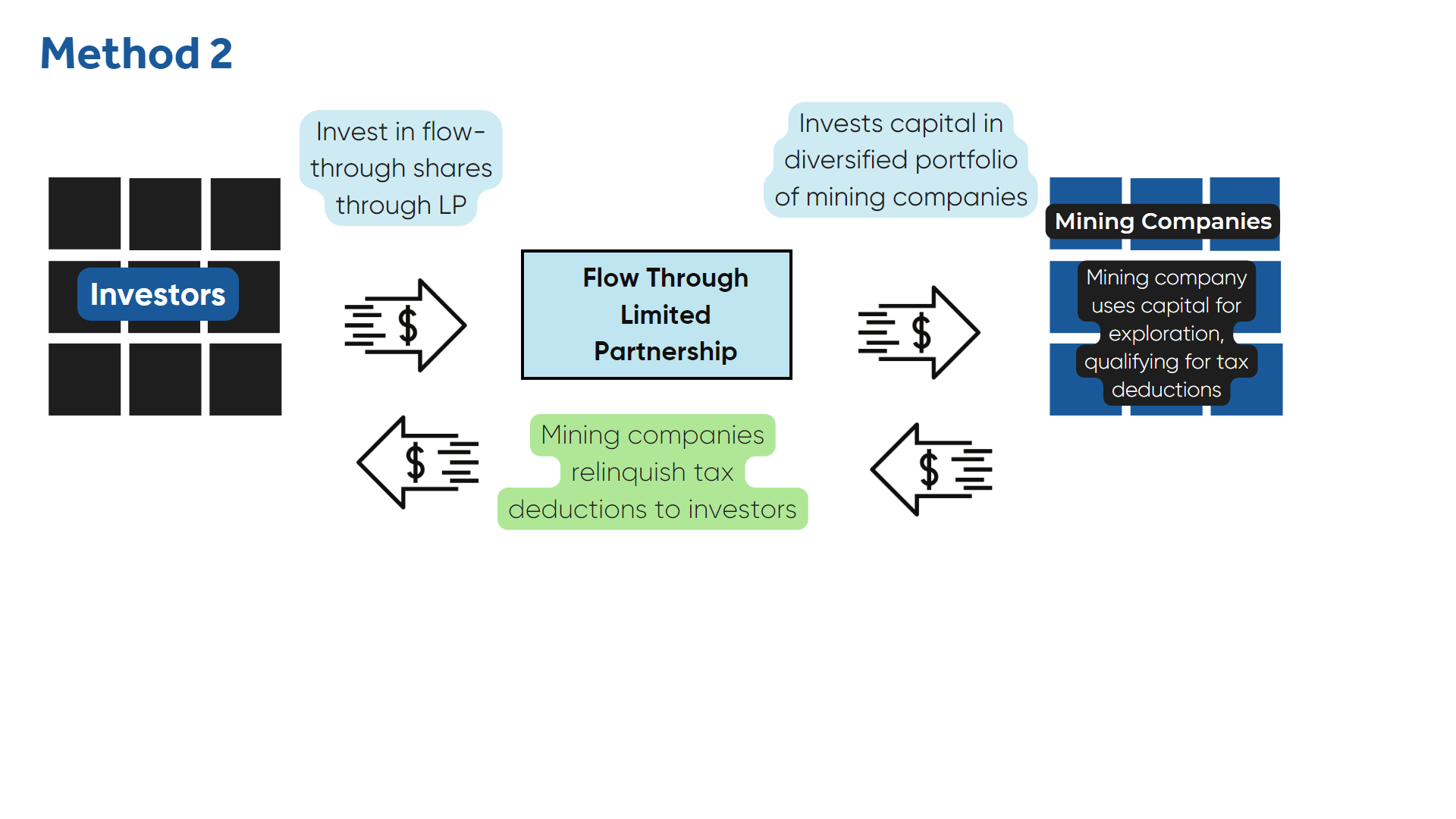Flow-Through Shares
If you are a high-income earner, it pays to plan ahead and explore ways to reduce your tax liability. Flow-through investments are specifically aimed at individuals with high taxable income. If you are in that category, they are something you should be aware of.
They allow you to claim tax deductions equal to, or in some cases surpassing, the amount invested.
This article explains what flow-through shares are and how they work. If you would like more information about the subjects discussed, please contact us with the information on the last page.
What are Flow-Through Shares?
In simple terms, flow-through shares are shares of a company, usually a mining or commodity start-up, that allow the investor to claim tax deductions from the federal, and in some cases, provincial government.
Flow-through shares were originally created in 1972 to support the Canadian mining industry. Eligible companies can claim expenses for exploration conducted on Canadian soil against their income. Because junior mining and resource companies generally do not generate revenue, they have nothing to deduct the expenses against. Under the Income Tax Act, they can pass on the tax deduction to investors who can then apply it against their personal income.
In effect, it enables public companies to transfer exploration expenditures to investors who can take advantage of the corresponding tax incentives, thereby “flowing their benefits through” to the shareholder.
“Did You Know? Flow-through share financing now contributes more than 65% of the funds raised on Canadian stock exchanges for exploration.”
Investors in a high tax bracket can use the tax credits from flow-through investments to bring down their personal tax owing. Depending on their province of residence, shareholders may be eligible for additional provincial tax credits beyond the standard federal credits. This is known as a super flow-through.
Are Flow-Through Investments Right for You?
Generally, this kind of investment is suitable for accredited investors, particularly those that are hitting the top tax bracket and currently making more than $225,000 a year. These high-income earners with large tax bills can avoid paying that tax directly to the government and invest in a flow-through for a 1:1 tax credit.
They are only suitable if you have a high risk tolerance. Companies that sell flow-through shares are emerging small-cap or micro-cap stocks. They are usually volatile and highly speculative.
Government tax credits, such as Canadian Exploration Expenses (CEE), mitigate this risk to some degree. When combined, they can be significant enough that it may mean keeping 40 cents or more on every dollar spent as opposed to paying taxes to the government and never seeing the money again.
Remember, federal and provincial governments want to incentivize investors to give their capital to these companies. Even if the stock price drops, shareholders can recoup some or all their investment in the form of tax savings.
Super Flow-Through Shares
If you are looking to maximize your tax savings, you may want to find out if you are eligible for super flow-through shares.
Certain provincial governments, including B.C., Ontario, Manitoba, and Quebec, offer an additional tax deduction, such as the Ontario Focused Flow-Through Share Tax Credit, to fund exploration taking place within their jurisdictions. To qualify, you must be a resident of one of these provinces.
Super flow-through investments can significantly reduce the cost of your investment and lead to even higher tax savings.
If you live in a province that has additional tax credits, it makes sense to focus on those companies or LPs to maximize their tax reduction.
For investors living outside of those provinces, there are other ways to make the most of flow-through shares. They include additional tax credits for mineral exploration such as the 15% Mineral Exploration Tax Credit (METC), and 30% Critical Mineral Exploration Tax Credit (CMETC).
Typically, flow-through shares are used through a mining or commodity start-up.
How Flow-Through Shares Work
There are two methods of investing in flow-through shares. The first is a direct placement of funds with an individual mining company. This is the riskiest method as there is a concentration of money into one company’s efforts in exploration and development.
Only accredited investors are eligible for direct flow through investments due to the inherent risks involved with exploration and development. To find out more about becoming an accredited investor, visit the Accredited Capital Corporation website.
The other method is through a Limited Partnership (LP). Similar to a mutual fund, an LP pools investors’ money together and splits it across multiple direct flow-throughs. They are often packaged together by province to take advantage of super flow-through opportunities.
The investor buys shares in a flow-through LP. The LP then invests in a portfolio of mining and resource stocks. The companies then use the money for exploration for which they receive a government tax deduction. Rather than apply the deduction, the companies renounce it. The deduction then transfers, or “flows through” to the investor.
The diagrams below show how each method works.
Due to the pooled nature of the investment and the diversification of companies, the risk is less than that of a single placement. For this reason, Limited Partnerships will allow non-accredited investors to purchase their funds. However, there is still risk involved in these investments and thus an investor would need to have a high risk tolerance, as well as a high income that they need to offset, in order to invest.
If a flow-through eligible company is successful in its exploration and development, the investor could sell their shares in a year and regain some of their money.
In some cases, the right investment may even result in a capital gain if the company finds a significant reserve.
Example Investment
The table below is an example of the return from a flow-through investment based on different stock price fluctuations. You will notice that if the investor sells at a loss, they would recoup some of their investment in the form of tax savings.
Liquidity
Except for short duration flow throughs, liquidity is a consideration. Because flow through investments deal with exploration and development (which can take some time to achieve) the investments are typically held for a year before they are eligible to be sold.
However, it is worth bearing in mind that the same money would otherwise be sent to the government with no expectation of ever being seen again.
Conclusion
If you are looking to make tax savings, flow-throughs are worth consideration, provided you are a risk-tolerant investor who makes enough annual income to qualify for the highest tax bracket.
It is important to recognize that these are highly volatile, highly speculative stocks. The incentive is designed to help junior mining and resource companies with exploration expenses. This means they likely have not yet made a profit and, in some cases, may never be profitable.
Flow-through investments are not for everyone. They are complex and inherently risky. If you are thinking of adding them to your portfolio, an investment advisor can help you find eligible stocks, make LP recommendations, and maximize your tax savings.
If you know you have a large tax bill for the coming year, tax planning with Cash Management Group’s investment advisors can help reduce the amount you owe.
If you have any questions about the topics discussed in this article, call the Cash Management Group on 604-643-0101 or email cashgroup@cgf.com to speak to an advisor.
Market Updates
Our market commentary breaks down the latest business, financial and money news. If you’d like to receive all of our market update emails, send us an email by clicking the subscribe button. If you found this content helpful, share it widely!





